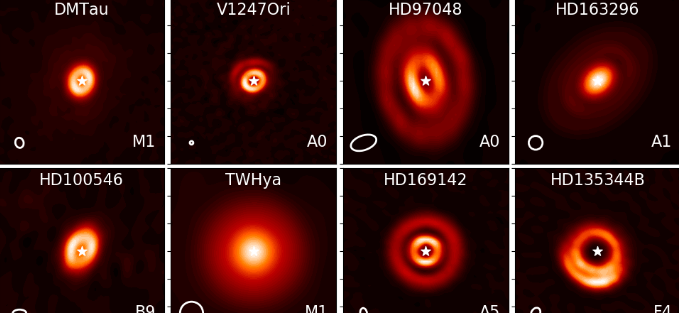Page 1 of 1
APOD: Young Star Cluster NGC 1333 (2024 Sep 12)
Posted: Thu Sep 12, 2024 4:05 am
by APOD Robot
 Young Star Cluster NGC 1333
Explanation: This spectacular mosaic
Young Star Cluster NGC 1333
Explanation: This spectacular mosaic of images from the James Webb Space Telescope peers into the heart of young star cluster NGC 1333. A mere 1,000 light-years distant toward the heroic constellation
Perseus, the nearby star cluster lies at the edge of the large Perseus molecular cloud. Part of Webb's deep
exploration of the region to identify low mass brown dwarf stars and free floating planets, the space telescope's combined field of view spans nearly 2 light-years
across the dusty cluster's turbulent stellar nursery. In fact, NGC 1333 is known to harbor stars less than a million years old, though most are
hidden from optical telescopes by the
pervasive stardust. The chaotic environment may be similar to one in which our own Sun formed over 4.5 billion years ago.
Re: APOD: Young Star Cluster NGC 1333 (2024 Sep 12)
Posted: Thu Sep 12, 2024 7:58 am
by alex555
On the lower right, is this a planetary disk seen edge-on ?
Re: APOD: Young Star Cluster NGC 1333 (2024 Sep 12)
Posted: Thu Sep 12, 2024 9:14 am
by Ann
alex555 wrote: ↑Thu Sep 12, 2024 7:58 am
On the lower right, is this a planetary disk seen edge-on ?
It is clearly a disk of some sort.
I'd say it's the the accretion disk, or the remnant of the accretion disk, around a young star. No obvious signs of planet formation can be seen at this resolution and magnification, at least no by me.
And Chris and others, this sort of stuff is
really not my forte. Please correct me if I am wrong!
Ann
Re: APOD: Young Star Cluster NGC 1333 (2024 Sep 12)
Posted: Thu Sep 12, 2024 2:57 pm
by Chris Peterson
Ann wrote: ↑Thu Sep 12, 2024 9:14 am
alex555 wrote: ↑Thu Sep 12, 2024 7:58 am
On the lower right, is this a planetary disk seen edge-on ?
It is clearly a disk of some sort.
APOD 12 September 2024 detail.png
I'd say it's the the accretion disk, or the remnant of the accretion disk, around a young star. No obvious signs of planet formation can be seen at this resolution and magnification, at least no to me.
And Chris and others, this sort of stuff is
really not my forte. Please correct me if I am wrong!
Ann
It's certainly similar to this protostar captured by the near-IR capabilities of the HST.
_
Re: APOD: Young Star Cluster NGC 1333 (2024 Sep 12)
Posted: Thu Sep 12, 2024 6:22 pm
by johnnydeep
Chris Peterson wrote: ↑Thu Sep 12, 2024 2:57 pm
Ann wrote: ↑Thu Sep 12, 2024 9:14 am
alex555 wrote: ↑Thu Sep 12, 2024 7:58 am
On the lower right, is this a planetary disk seen edge-on ?
It is clearly a disk of some sort.
APOD 12 September 2024 detail.png
I'd say it's the the accretion disk, or the remnant of the accretion disk, around a young star. No obvious signs of planet formation can be seen at this resolution and magnification, at least no to me.
And Chris and others, this sort of stuff is
really not my forte. Please correct me if I am wrong!
Ann
It's certainly similar to this protostar captured by the near-IR capabilities of the HST.
_
hubble_j167283529_ic2631_protostar_inset_display-jpg.jpg
And the "
This spectacular mosaic" link has this to say about it:
Many of the young stars in this image are surrounded by disks of gas and dust, which may eventually produce planetary systems. On the right hand side in the image, we can glimpse the shadow of one of these disks oriented edge-on - two dark cones emanating on opposite sides, seen against a bright background.
Re: APOD: Young Star Cluster NGC 1333 (2024 Sep 12)
Posted: Thu Sep 12, 2024 7:41 pm
by Ann
I said in my previous post in this thread that I could see no signs of planet formation in the disk around a young star inside NGC 1333. But what would such signs look like?
The way I understand it, a newly formed planet would reveal itself as a gap in a protoplanetary disk, and the young planet will clear an orbital path around its star and remove much of the dust and debris from this path.
But since the disk in NGC 1333 is seen almost exactly edge on, I don't suppose we will be able to see any gaps in it.
Ann
Re: APOD: Young Star Cluster NGC 1333 (2024 Sep 12)
Posted: Sat Sep 14, 2024 1:43 pm
by AVAO
Ann wrote: ↑Thu Sep 12, 2024 7:41 pm
I said in my previous post in this thread that I could see no signs of planet formation in the disk around a young star inside NGC 1333. But what would such signs look like?
The way I understand it, a newly formed planet would reveal itself as a gap in a protoplanetary disk, and the young planet will clear an orbital path around its star and remove much of the dust and debris from this path.
But since the disk in NGC 1333 is seen almost exactly edge on, I don't suppose we will be able to see any gaps in it.
Ann
Unfortunately I couldn't figure out where the disk ends and where the shadow begins.
But definitely a very exciting area and one of my favorite clouds...
https://photojournal.jpl.nasa.gov/catalog/PIA03545
SST-IRAQ
See the whole story:
viewtopic.php?t=43077&sid=8d74b6c90f6c8 ... 8a#p330476
 Young Star Cluster NGC 1333
Young Star Cluster NGC 1333



